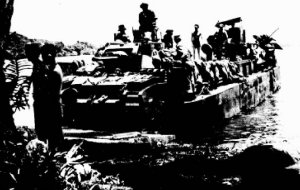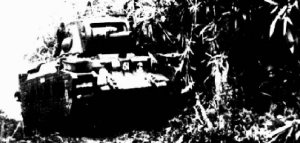Sattleberg Road, New Guinea 1943
Previous -
Index -
Next
The next opportunity in the Australian mandate territory of Papua-New Guinea to use tanks was during mid-November 1943 when Matildas of ‘C Squadron, 1Army Tank Battalion, were given a chance to prove their worth in support of the AIF 9Division in the assault up Satelberg Road on the Huon Peninsula. Maj Ford investigated the Finschhafen area the previous month and reported infantry tanks could be used in further operations. So LST’s carrying 9 officers, 136 troops embarked 18 tanks including the Close Support (CS) Matilda variant, 5 jeeps and trailers plus ten days supply of rations, ammunition and fuel. Arriving during a steady downpour of tropical rain on the sultry night of 20 October Maj Horden’s ‘C Squadron disembarked at Langemak Bay. The AIF 26Bde and the Matilda II Infantry tank squadron did more training to work out the best tactics and methods of command, cooperation and control. Then the Matilda’s were moved from Kedam Beach to Launch Jetty and moved west up the Satelberg Road towards Jivevanang in bright moonlight. The going was hard, the road was steep and slippery, and the really sharp bends on the road made rounding difficult. Yet two tanks bogged on the way, then all were towed into position with switched off motors and eventually by the 15 November all nine aggressive Matilda’s were hidden in the bamboo thickets east of Jivevanang. Next morning the tanks reached the start-line at the junction of Sisi track a boulevard through dense bamboo and jungle vegetation, and Satelberg Road a narrow muddy track along a high ridge.

The general intention was for the 26Bde to press towards Satelberg summit along the axis of the road with the 2/48Btn. When the tanks make contact with the enemy they were to blast the bunkers open and with the infantry close by to protect each tank, to mop up with the platoon commander directing the tanks to ‘rake with Besa’ and discharge high-explosive at the areas needed. Heavy artillery, mortars and medium machine-gun concentrations at 7am herald the opening offensive. The attack westward made rapid progress and continued in a series of short bounds with Matlidas firing at both sides of the road, the Japanese held their ground tenaciously and replied with machine-guns, mortars and grenades until blown out with close range tank fire. Three jeeps were loaded with ammunition had to be sent forward because of the liberal usage by the tank crews after continuous training for the past two years. The advance continued across the slopes of Kunai Knoll and the southern end of Coconut Ridge where an unexploded artillery shell blew the track off the leading tank. Meanwhile the Japanese had withdrawn and Lieut O’Donnel's troop of tanks were sent forward to aid a further advance, but instead of swapping tank positions they merely replaced the fatigued crew, so by 8am the next day the fresh troopers were in the forward tanks and the advance continued. Capt Isaksson’s company had met entrenched and camouflaged machine-gun positions but a Matilda soon took care of that obstacle, the stubborn Japanese were delaying to organise digging a broad ditch across the track.
The speed with which the Japanese organised anti-tank measures was impressive nevertheless with the aid of Maj Moodie’s engineers of the 2/13FldCo the tanks were able to traverse these obstacles. A Japanese 37mm anti-tank gun repeatedly clashed with a Matilda but the damage was soon repaired, also the side of the track began to break away and quickly using hand tools the sappers prevented a disaster. Further along the road the tanks overran an 81mm mortar position and later a Woodpecker, the Japanese heavy machine-gun. The 2/24Btn on the right flank moving north were to advance on, and through 2200 feature with the help of a troop of tanks though the promise of them arriving was too much to ask, still a track was ordered to be cut. Maj Horden arrived with a tracked bulldozer and promptly starts to bulldoze a route through the most difficult terrain the Australians had encountered. When the new tank track Spry Street was ready a third company prepared to support the two frontward companies, but here preliminary patrols discovered the starving Japanese had vacated that position. Meanwhile on Satelberg track as a result in the advance across the razor back ridges the Matildas broke away the road edge and were in danger of slipping down the steep side of the hill, the close support of the Matildas would be delayed. Four days of strenuous fighting and steady progression culminated in a final overpowering infantry assault that secured Steeple Tree Hill where the 2/48Btn linked with the 2/23Btn, then the latter moving from the south, continues on the left flank to encircle the enthralled Japanese high point. The Australians had reached the southern slopes of the Satelberg feature and here the stalwart Japanese defenders were met in considerable strength and density, also a landslide across the road utterly prevented and finalised the further use of the tanks.

In the following morning overcast mist, and while artillery registration took sometime, the no-man’s land patrols from Capt Hill’s company pushed forward 150yards to the last enemy foxholes on the summit, they reported the positions were unoccupied and the Japanese again had moved out. It was in the preceding battles for Satelberg summit that Sergeant T.C. Derrick, veteran of Tobruk and El Alemain, was awarded the Victoria Cross and on the 25 November 1943 at 10am he tied the Australian flag to a scarred and withered tree over Satelberg. An inglorious end to the days of hard fighting through difficult terrain but meanwhile a troop of Matildas had crawled frontward to 2200 feature just in case. During the jungle battles 26Bde captured two 75mm guns, three 37mm guns, 18 heavy machine-guns and large numbers of light-mg’s, mortars and rifles with, "many of the lads consider it to have been harder and more nerve-racking than any ten days at Tobruk or El Alamein", wrote one of the battalion diarists.
Previous -
Index -
Next
|


